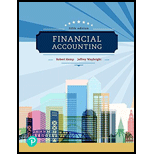
Financial Accounting
5th Edition
ISBN: 9780134728643
Author: Robert Kemp; Jeffrey Waybright
Publisher: Pearson Education (US)
expand_more
expand_more
format_list_bulleted
Textbook Question
Chapter 8, Problem 1WC
Written Communication
A client of yours notified you that she just closed a deal to purchase an existing business. It’s a pretty hefty purchase. As part of the purchase of the business, she receives the land, the building, all the equipment, and the entire merchandise inventory of the company purchased. Your client e-mailed you a copy of the closing statement, along with the breakdown of the purchase price; these are shown below. In the e-mail, your client expressed concern about how to account for the $1 ,800,000 paid for the land and building. She also wanted to know the proper way to account for the merchandise inventory and the
| Asset List | |
| Description | Amount |
| Land and Building........................................... | $1,800,000 |
| Equipment...................................................... | 725,000 |
| Inventory............................................... | 450,000 |
| Goodwill....................................................... | 300,000 |
| Total Purchase Price................... | $3,275,000 |
Requirement
- 1. Prepare an e-mail to your client explaining how the $1,800,000 should be allocated between the land and building, as well as how the merchandise inventory and goodwill should be accounted for.
Expert Solution & Answer
Trending nowThis is a popular solution!

Students have asked these similar questions
What is the amount of gross profit for the year on these financial accounting question?
Need help this question general accounting
Rent expense in Cascade Corporation's 2023 income statement is.... please provide answer the financial accounting question
Chapter 8 Solutions
Financial Accounting
Ch. 8 - Prob. 1DQCh. 8 - Prob. 2DQCh. 8 - Prob. 3DQCh. 8 - What is depreciation, and why is it used in...Ch. 8 - Prob. 5DQCh. 8 - Which depreciation method would be moot...Ch. 8 - Prob. 7DQCh. 8 - Prob. 8DQCh. 8 - Prob. 9DQCh. 8 - Prob. 10DQ
Ch. 8 - Prob. 1SCCh. 8 - Prob. 2SCCh. 8 - How should a capital expenditure for a long-term...Ch. 8 - Which depreciation method usually produces the...Ch. 8 - Prob. 5SCCh. 8 - Prob. 6SCCh. 8 - Prob. 7SCCh. 8 - Prob. 8SCCh. 8 - Prob. 9SCCh. 8 - Prob. 10SCCh. 8 - Prob. 11SCCh. 8 - Prob. 12SCCh. 8 - Prob. 1SECh. 8 - Long-term asset terms (Learning Objective 1) 5-10...Ch. 8 - Prob. 3SECh. 8 - Lump-sum purchase (Learning Objective 2) 5-10 min....Ch. 8 - Errors in accounting for long-term assets...Ch. 8 - Concept of depreciation (Learning Objective 3)...Ch. 8 - Depreciation methods (Learning Objective 3) 10-15...Ch. 8 - Depreciation methods (Learning Objective 3) 10-15...Ch. 8 - Prob. 9SECh. 8 - Prob. 10SECh. 8 - Prob. 11SECh. 8 - Prob. 12SECh. 8 - Prob. 13SECh. 8 - Prob. 14SECh. 8 - Prob. 15SECh. 8 - Other long term assets (Learning Objective 8) 5-10...Ch. 8 - Prob. 17SECh. 8 - Prob. 18AECh. 8 - Prob. 19AECh. 8 - Prob. 20AECh. 8 - Prob. 21AECh. 8 - Depreciation methods (Learning Objective 3) 15-20...Ch. 8 - Prob. 23AECh. 8 - Prob. 24AECh. 8 - Prob. 25AECh. 8 - Prob. 26AECh. 8 - Prob. 27AECh. 8 - Prob. 28AECh. 8 - Prob. 29AECh. 8 - Prob. 30AECh. 8 - Prob. 31AECh. 8 - Prob. 32BECh. 8 - Prob. 33BECh. 8 - Prob. 34BECh. 8 - Prob. 35BECh. 8 - Prob. 36BECh. 8 - Prob. 37BECh. 8 - Prob. 38BECh. 8 - Prob. 39BECh. 8 - Prob. 40BECh. 8 - Prob. 41BECh. 8 - Prob. 42BECh. 8 - Prob. 43BECh. 8 - Prob. 44BECh. 8 - Prob. 45BECh. 8 - Long-term asset costs and partial-year...Ch. 8 - Journalizing long-term asset transactions...Ch. 8 - Prob. 48APCh. 8 - Prob. 49APCh. 8 - Prob. 50APCh. 8 - Prob. 51APCh. 8 - Prob. 52APCh. 8 - Prob. 53BPCh. 8 - Journalizing long-term asset transactions...Ch. 8 - Prob. 55BPCh. 8 - Prob. 56BPCh. 8 - Prob. 57BPCh. 8 - Prob. 58BPCh. 8 - Prob. 59BPCh. 8 - Prob. 1CECh. 8 - Prob. 1CPCh. 8 - Continuing Financial Statement Analysis Problem...Ch. 8 - Prob. 1EIACh. 8 - Prob. 2EIACh. 8 - Financial Analysis Purpose: To help familiarize...Ch. 8 - Prob. 1IACh. 8 - Prob. 1SBACh. 8 - Written Communication A client of yours notified...
Knowledge Booster
Learn more about
Need a deep-dive on the concept behind this application? Look no further. Learn more about this topic, accounting and related others by exploring similar questions and additional content below.Similar questions
- Please answer the financial accounting questionarrow_forwardProvide answer general accountingarrow_forwardIf an oil rig was built in the sea, the cost to be capitalised is likely to include the cost of constructing the asset and the present value of the cost of dismantling it. If the asset cost $10 million to construct, and would cost $4 million to remove in 20 years, then the present value of this dismantling cost must be calculated. If interest rates were 5%, the present value of the dismantling costs are calculated as follows: $4 million x 1/1.0520 = $1,507,558 The total to be capitalised would be $10 million + $1,507,558 = $11,507,558. This would be depreciated over 20 years, so 11,507,558 x 1/20 = $575,378 per year. Each year, the liability would be increased by the interest rate of 5%. In year 1 this would mean the liability increases by $75,378 (making the year end liability $1,582,936). This increase is taken to the finance costs in the statement of profit or loss.arrow_forward
arrow_back_ios
SEE MORE QUESTIONS
arrow_forward_ios
Recommended textbooks for you
- Century 21 Accounting Multicolumn JournalAccountingISBN:9781337679503Author:GilbertsonPublisher:Cengage

Century 21 Accounting Multicolumn Journal
Accounting
ISBN:9781337679503
Author:Gilbertson
Publisher:Cengage





Revenue recognition explained; Author: The Finance Storyteller;https://www.youtube.com/watch?v=816Q6pOaGv4;License: Standard Youtube License